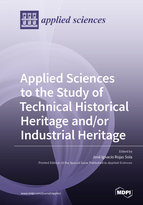Applied Sciences to the Study of Technical Historical Heritage and/or Industrial Heritage
A special issue of Applied Sciences (ISSN 2076-3417).
Deadline for manuscript submissions: closed (25 February 2020) | Viewed by 44473
Special Issue Editor
Interests: engineering graphics; industrial heritage; industrial archaeology; history of technology and industrial revolution; historical inventions; mechanical engineering; computer-aided design; computer-aided engineering
Special Issues, Collections and Topics in MDPI journals
Special Issue Information
Dear Colleagues,
The study of cultural heritage, in particular of the technical historical heritage and/or industrial heritage, is becoming increasingly important. In general, cultural heritage follows a value chain consisting of seven clearly differentiated milestones: identification, registration and research; protection; training; conservation and restoration; value and dissemination; heritage management; and the application of new technologies. However, this Special Issue focuses only on the valorization and diffusion, as well as the use of new technologies, concentrating on research from three main aspects: location, documentation and dissemination.
The scope for case studies is very broad and can cover different disciplines of engineering, such as mechanical engineering, civil engineering, chemical engineering, electrical and electronic engineering, automation and robotic engineering or telecommunications engineering, among others, as well as industrial architecture. In particular, we especially welcome research on historical inventions related to these fields of engineering and architecture, as well as studies of the work (historical inventions) of world-renowned engineers and architects.
This Special Issue invites researchers to submit original research papers and review articles related to any discipline in which the theoretical or practical issues of technical historical heritage and/or industrial heritage are considered. The topics of interest include, but are not limited to:
- historical technical heritage
- industrial heritage
- industrial archaeology
- industrial architecture
- ancient artifacts (historical inventions
- computer-aided design
- computer-aided engineering;
- geometric modeling
- computer animation
- virtual reality
- augmented reality
- engineering graphics
- multimedia
- and 3D printing
Contributions in other domains are welcome, although we ask that you please contact the Guest Editor.
Prof. Dr. José Ignacio Rojas Sola
Guest Editor
Manuscript Submission Information
Manuscripts should be submitted online at www.mdpi.com by registering and logging in to this website. Once you are registered, click here to go to the submission form. Manuscripts can be submitted until the deadline. All submissions that pass pre-check are peer-reviewed. Accepted papers will be published continuously in the journal (as soon as accepted) and will be listed together on the special issue website. Research articles, review articles as well as short communications are invited. For planned papers, a title and short abstract (about 100 words) can be sent to the Editorial Office for announcement on this website.
Submitted manuscripts should not have been published previously, nor be under consideration for publication elsewhere (except conference proceedings papers). All manuscripts are thoroughly refereed through a single-blind peer-review process. A guide for authors and other relevant information for submission of manuscripts is available on the Instructions for Authors page. Applied Sciences is an international peer-reviewed open access semimonthly journal published by MDPI.
Please visit the Instructions for Authors page before submitting a manuscript. The Article Processing Charge (APC) for publication in this open access journal is 2400 CHF (Swiss Francs). Submitted papers should be well formatted and use good English. Authors may use MDPI's English editing service prior to publication or during author revisions.
Keywords
- Technical Historical Heritage
- Industrial Heritage
- Industrial Archaeology
- Industrial Architecture
- Ancient Artifacts
- Historical Inventions
- Computer-Aided Design
- Computer-Aided Engineering
- Geometric Modeling
- Computer Animation
- Virtual Reality
- Augmented Reality
- Engineering Graphics
- Multimedia
- 3D printing






